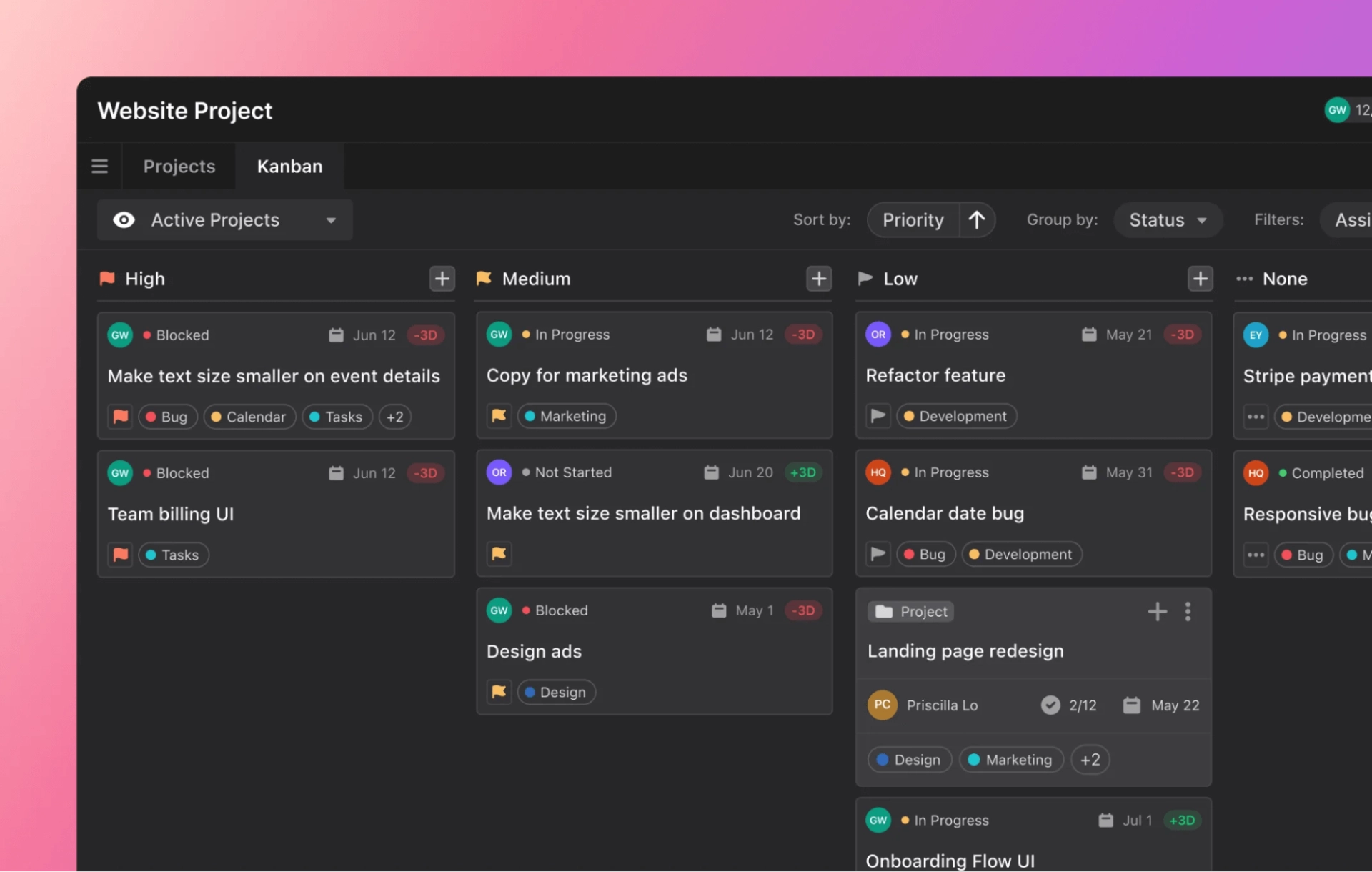The average employee attends 17.7 meetings per week. But how many of them are truly productive?
Unfortunately, painfully long, unproductive meetings occur all too often.
Fortunately, there’s a straightforward solution to this problem: meeting agendas.
A meeting agenda sets clear expectations for what needs to happen before, during, and after each meeting. This keeps all participants aligned and focused.
In this article, we discuss how to create an effective meeting agenda. You’ll also find examples and templates for 10 different types of meetings.
What is a meeting agenda?
A meeting agenda is a pre-planned document detailing the topics that will be discussed, their order, and their allotted times in an upcoming meeting. Its purpose is to help the meeting attendees understand what’s to be discussed, who’s responsible for presenting each topic, and the meeting’s expected outcomes.
Why should you use a meeting agenda?
Meeting agendas allow for the following:
Better preparation
All meeting participants will know what will be discussed in the meeting, enabling them to prepare for it in advance. Ample preparation leads to more productive and focused discussions.
An agenda also helps ensure that the attendees will bring the necessary documents or data.
Clearer communication
When there are multiple topics to discuss, it’s easy to go off on a tangent. A meeting agenda sets clear expectations for what will be spoken about, which helps avoid rabbit holes and confusion.
Clear communication also helps the team understand how the meeting’s objectives align with the company’s overarching goals.
Improved time management
Planning specific time slots for each meeting topic ensures that every minute is used effectively and prevents the meetings from going overtime. Moreover, it shows that you respect the participants’ time and contributes to a culture of punctuality and accountability.
What to include in a meeting agenda
An effective meeting agenda should include the following sections:
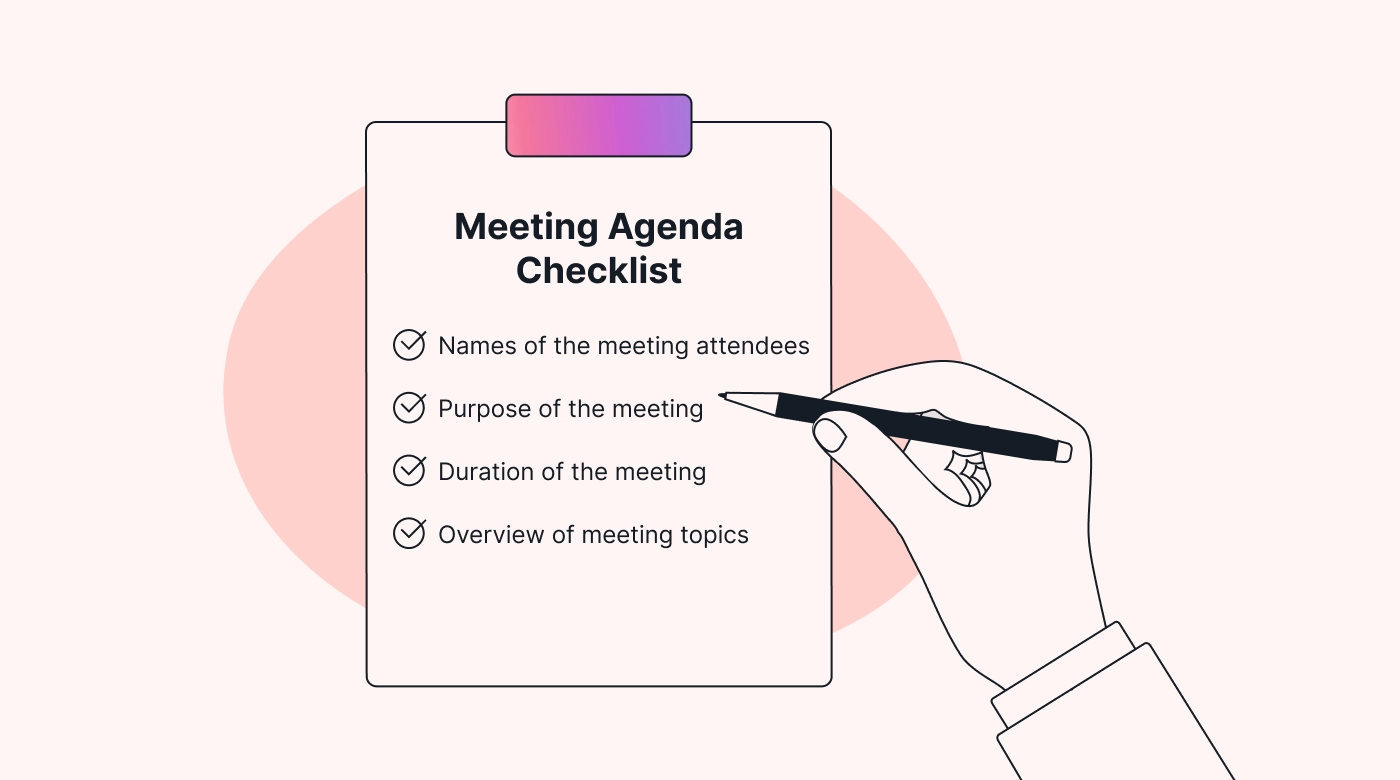 |
- The names of the meeting attendees: This clarifies who is expected to participate.
- The purpose of the meeting: This defines the meeting’s objectives.
- The duration of the meeting: This indicates how long the meeting — or even each agenda item — is expected to last.
- An overview of the topics you’ll be discussing: This ensures all the necessary topics will be covered.
What makes a great meeting agenda?
A great meeting agenda is carefully organized and intentionally structured. It should have the following qualities:
Clear objectives
An effective meeting agenda contains clear, achievable goals. While there may be many topics to discuss, don’t try to jam-pack everything into an hour-long meeting. Instead, prioritize the most critical issues and allocate enough time for in-depth discussion on those topics.
Participant roles
Clearly defined participant roles let everyone know their responsibilities both before and during the meeting. This includes who will lead specific discussion topics, who will present data, and who will take meeting notes.
Pre-defined roles keep everyone accountable and improve the meeting’s flow.
Time allocations
Scheduling specific time slots for each agenda item helps you manage the meeting’s pace. It ensures that the discussions stay on track and the participants don’t get distracted by side conversations or irrelevant topics.
Flexibility for unplanned discussions
While we’ve already stressed the importance of having a structured meeting agenda, planning for some flexibility is equally important.
Making the agenda flexible allows for spontaneous discussions to happen without derailing the planned structure. This balance ensures that the meeting remains focused but adaptable to unexpected, pressing issues.
Follow-up actions
Too often, meeting attendees leave a session confused about their next steps. Keeping meeting minutes and having clear follow-up action items, such as assigning responsibilities and deadlines for new or upcoming tasks, keeps your team accountable and drives tangible outcomes.
How to create a meeting agenda
You now know what makes a meeting agenda a great one. To give you even more clarity, here’s a detailed step-by-step guide you can follow for future meetings:
1. Determine the meeting type
Figure out what kind of meeting you’ll be having. Will it be formal or informal? In-person or virtual?
Deciding on the meeting format will help you set the right tone and structure for your meeting agenda.
For example, if the meeting’s purpose is to brainstorm ideas, an informal and flexible agenda might be best, as it’ll allow for free-flowing discussion and creativity.
On the other hand, if the goal is to make strategic decisions for a project, a detailed agenda with fixed time slots and specified participants for each topic might be more suitable.
2. Identify the meeting objective
Come up with a clear, achievable goal for the meeting to keep the discussion focused and productive. This step sets the meeting’s direction and purpose from the outset.
Your meeting objective should align with broader team or project goals.
Make the objective purposeful and specific, too. So, instead of stating a vague intention, like “Discuss project status,” say, “Determine the next steps for [Project Name] to meet the deadline by the end of Q2.”
Specificity will help the participants prepare effectively and guide more meaningful, outcome-oriented discussions.
3. Define key topics
Determine the list of topics the meeting will cover and prioritize them based on their importance and relevance to the meeting’s objectives. After you make this list, if you feel like some of the topics are irrelevant, refer to your meeting objectives as guidance to keep the agenda focused.
For project or team meetings, it’s good practice to involve your team members in suggesting discussion items. They may bring up other critical points that you previously overlooked.
4. Allocate time for each agenda item
Decide how much time should be spent on each topic based on how long the meeting is planned for and how in-depth the conversation is expected to be. Each item on the agenda should receive the amount of attention it needs within the scheduled time frame.
As mentioned earlier, always include some buffer time for unexpected discussions or deeper dives into complex topics. It’s better to have a bit of wiggle room than to feel rushed through important discussions.
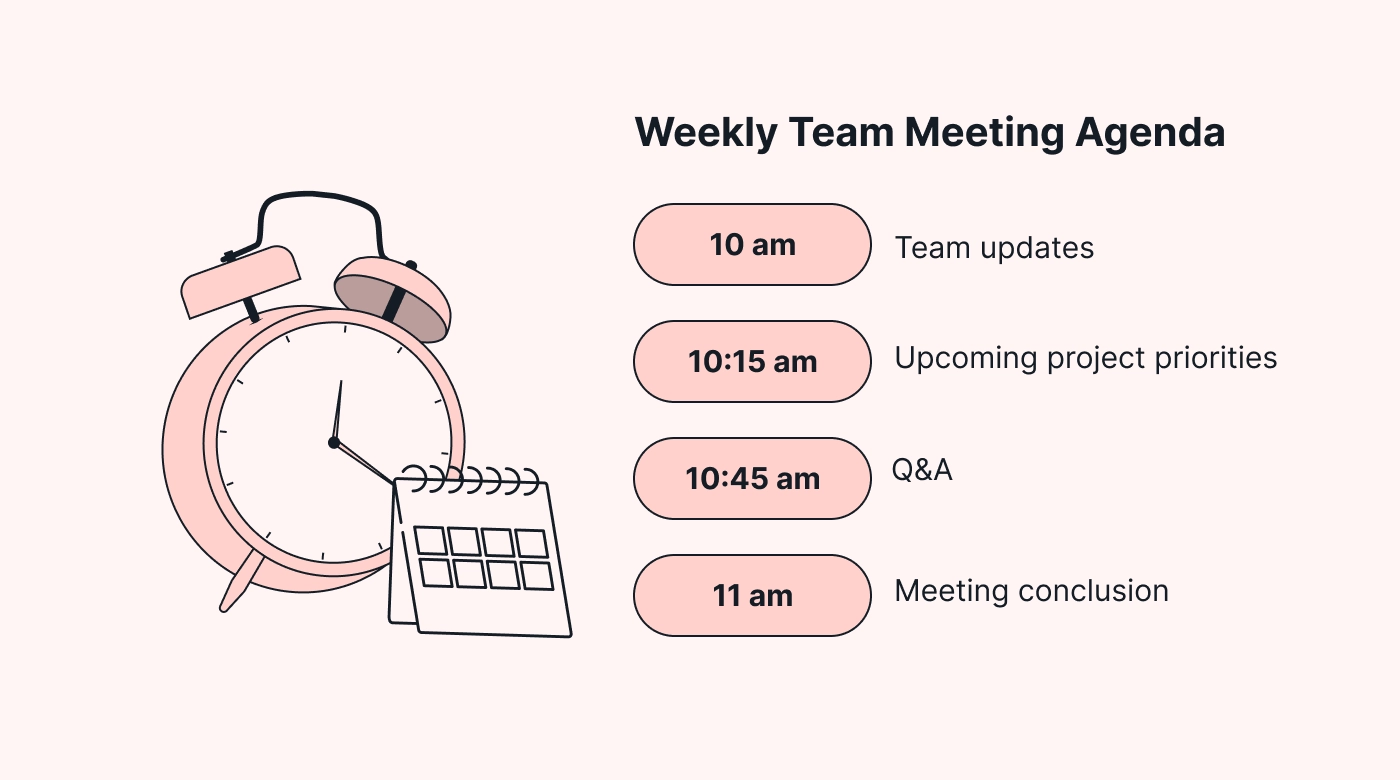 |
Additionally, allocate an extra 10 minutes at the end of each portion of the meeting for a Q&A session or to provide a brief recap of the key decisions and next steps.
5. List any necessary documents
Include any relevant documents, reports, or data that the participants should review before the meeting. This is a small but important step that will save you and your team time and confusion down the line.
All these materials need to be easily accessible to the meeting participants. You can do this through shared drives or collaboration platforms. Motion, for instance, allows you to attach all meeting documents, spreadsheets, and images in one place, making them easy to share with your team.
6. Distribute the agenda
The final step is to share the agenda in advance with all the participants. This will give your team enough time to prepare and review any necessary documents or bring up additional topics that may need to be discussed.
Avoid making last-minute changes or sending the agenda out too close to when the meeting is scheduled to begin, as these things defeat the purpose of having a meeting agenda in the first place.
10 meeting agenda templates and examples
Creating a meeting agenda isn’t as complicated as you might think, especially if you have a template to work with. Here is a list of examples and templates for 10 common types of meetings:
1. One-on-one meeting agenda
Since one-on-one meetings are one of the more intimate meeting types, they’re an opportunity to discuss personal progress, set personal goals, and address any concerns. Each meeting should be tailored to the employee’s role, achievements, and areas for improvement.
It’s important to include time for feedback exchange and discussions during these meetings on issues such as expectations for upcoming projects, support needed from management, or personal development opportunities.
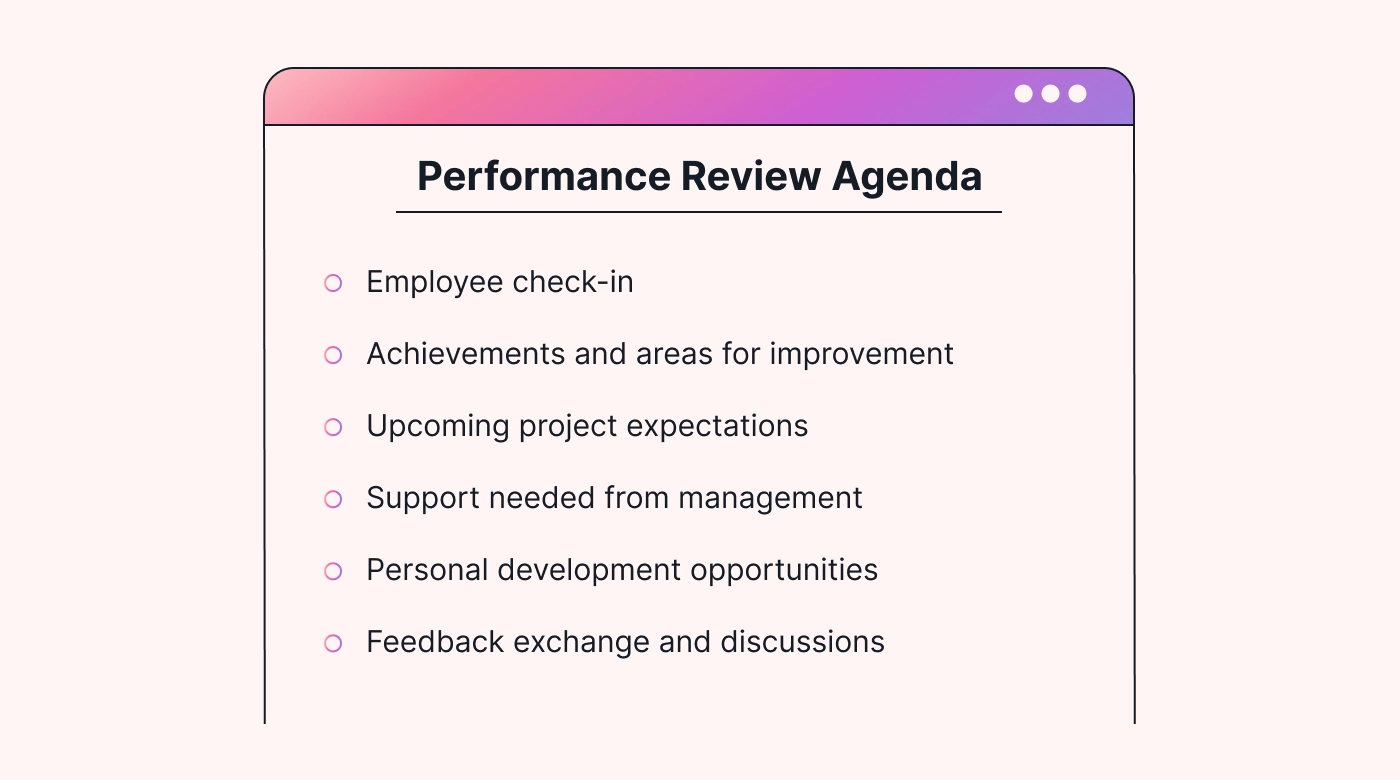 |
Use this template for:
- Performance reviews
- Remote check-ins
2. Daily scrum meeting agenda
A daily scrum is a meeting that briefly reviews what each team member accomplished yesterday and has planned for today. It helps quickly identify any obstacles that might hinder progress or require team input.
Remember to include key points such as completed tasks, planned tasks, and any blockers or challenges in your daily scrum meeting agenda.
Use this template for:
- Agile project updates
3. Weekly team meeting agenda
Weekly team meetings help teams stay aligned and informed on each other’s progress. Team meeting agendas should include sections for updates on ongoing projects, upcoming deadlines, and team announcements.
You should also allocate time for open discussions on team challenges or brainstorming sessions to encourage collaborative problem-solving.
Use this template for:
- Team project progress reviews
- Knowledge-sharing sessions
4. All-hands meeting agenda
All-hands meetings are for sharing company-wide news, achievements, and strategic directions. Because they’re typically intended for the entire company or a specific department, keep each segment short and simple to maintain engagement.
In addition, include time for employee recognition, Q&A sessions, or guest speakers.
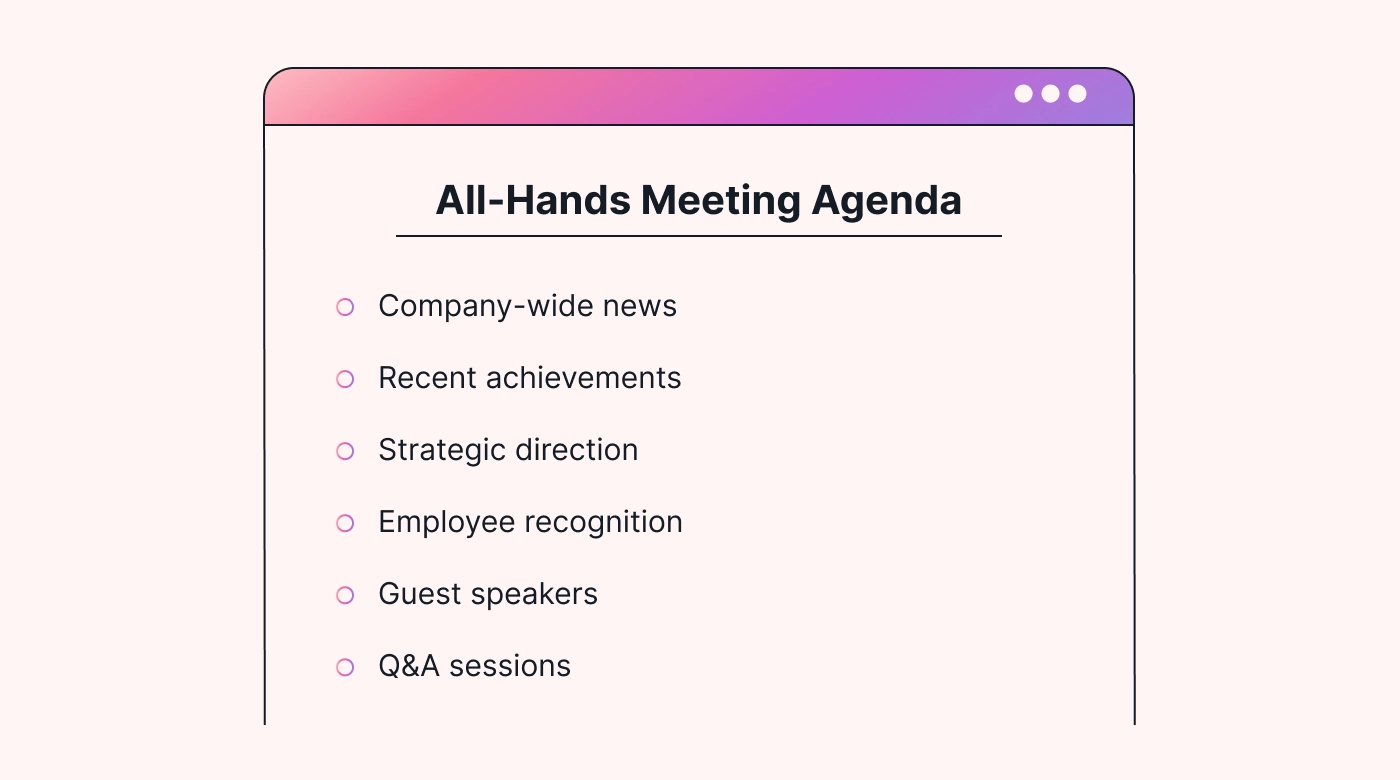 |
Use this template for:
- Quarterly company status updates
- Employee town hall or skip-level meetings
5. Monthly sales review meeting agenda
Sales review meetings, which analyze the past month’s sales data, can get overwhelming fast, especially if performance has been less than ideal.
For this type of meeting, your agenda should focus on determining key performance indicators (KPIs), identifying trends, and having a structured discussion on targets and objectives for the next period.
Check out our list of sales meeting agenda templates to help you keep your sales meetings productive and actionable.
Use this template for:
- Sales target reviews
- Market analysis updates
6. Annual strategy planning meeting agenda
An annual strategy planning meeting allows your team to reflect on the past year’s achievements, challenges, and lessons learned. This important meeting is when teams set goals, strategies, and key initiatives for the upcoming year.
A good agenda for an annual meeting should focus on reviewing how the previous year went, including what went well and what needs to be improved upon, and making plans for the upcoming year.
Use this template for:
- Long-term strategic planning meetings
- Budget-planning sessions
7. Project kickoff meeting agenda
Project kickoff meetings are aimed at presenting project scopes, objectives, and expected outcomes to all team members and stakeholders involved.
It’s best to include action items, team roles, and task assignments in this agenda, as this will help avoid confusion or overlap in responsibilities later on.
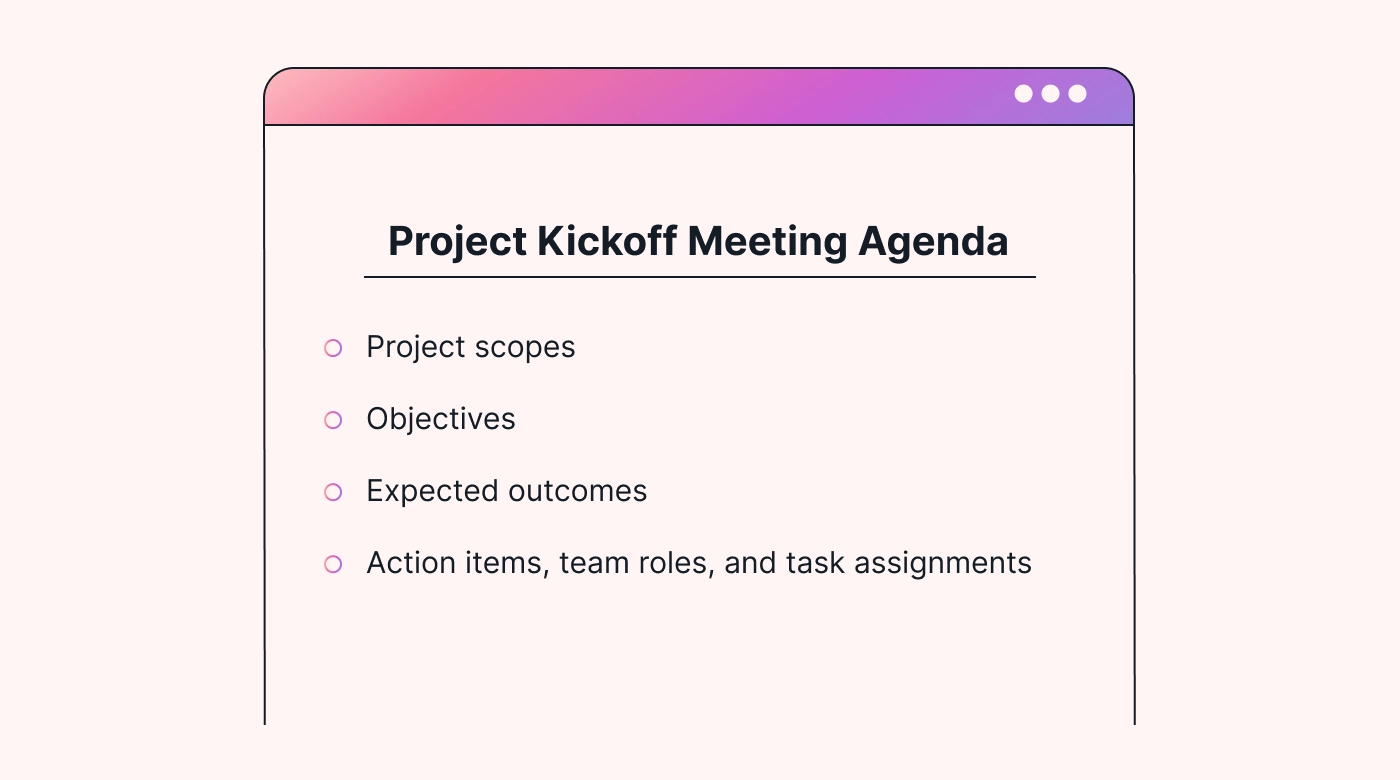 |
Use this template for:
- New project initiations
- Retrospective meetings to review these items
8. Cross-departmental collaboration meeting agenda
Cross-departmental meetings are important for each department to share updates and progress in collaborative projects.
Agendas for these meetings should include sections for each department to present their progress, accomplishments, and challenges. Also, allow time for other departments to help brainstorm possible solutions to problems.
Use this template for:
- Interdepartmental project updates
- Resource-sharing and coordination sessions
9. Client onboarding meeting agenda
A client onboarding meeting is often the first impression a new client has of your company. Introducing your team and explaining the onboarding process will help them understand who they’ll be working with and when they'll reach important milestones.
Don’t forget to discuss client expectations and goals and gather the necessary information for project initiation. This ensures your clients are informed and helps establish trust.
Use this template for:
- New client orientation
10. Stakeholder meeting agenda
Stakeholder meetings are used to present a project’s current status, any milestones achieved, and upcoming steps to internal or external stakeholders.
This is the time to be transparent about the project’s progress, any issues encountered, and how these challenges have been or will be addressed.
Your stakeholder meeting agenda should include segments that provide updates, address questions, and openly discuss stakeholder concerns and suggestions.
Use this template for:
- Investor update meetings
- Board meetings
Motion enhances meetings’ effectiveness
Motion offers a variety of features that will not only help you prepare for meetings but also enhance your meeting outcomes. Here’s what it can do for you:
Meeting Assistant
Ever wish someone could plan, organize, and schedule all your meetings for you? That dream can become reality with Motion’s Meeting Assistant.
This assistant identifies the best times for meetings and shares your availability with your teams automatically, eliminating the risk of scheduling conflicts. It also allows you to create meeting agendas that are more considerate of participants’ availability and workload.
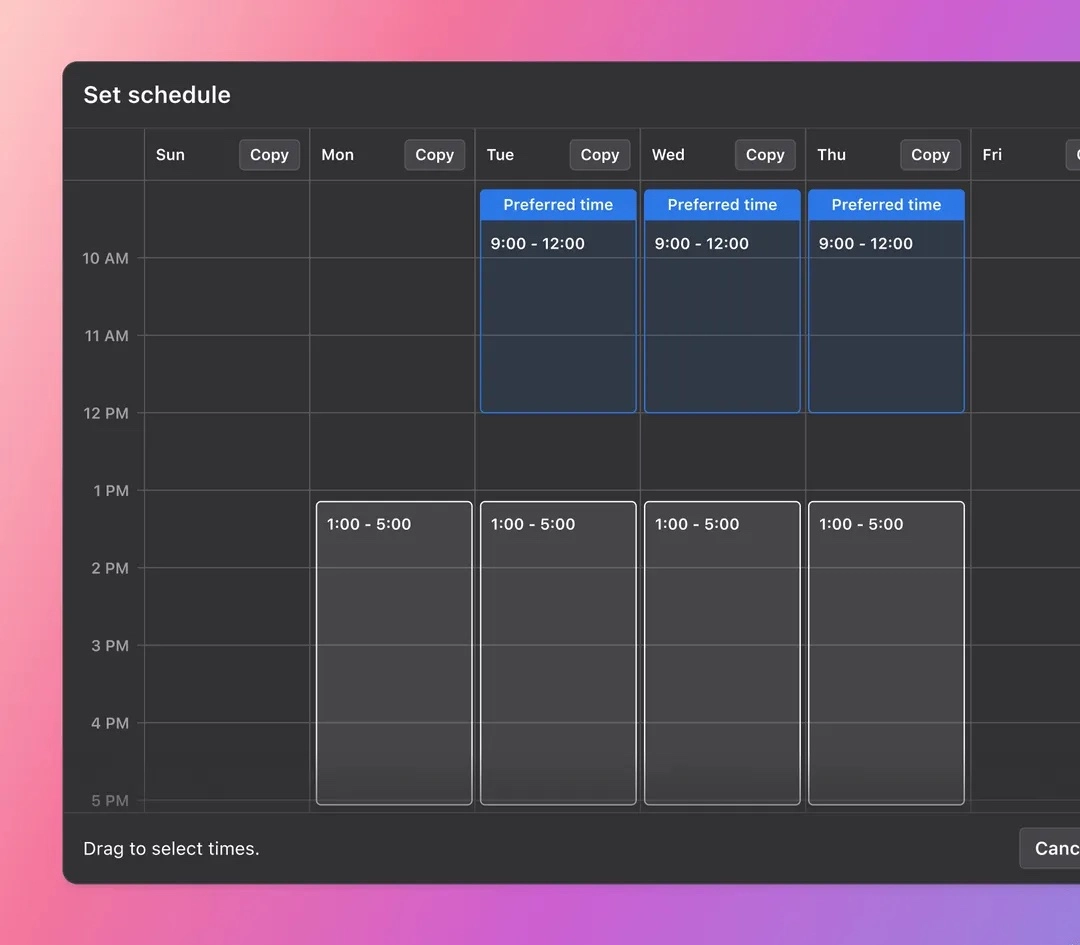 |
Template creation and document management
Store all meeting documents in one place for easy access before, during, and after the meeting.
Motion simplifies collaboration and document-sharing among team members. You’ll also be able to take meeting notes directly on our project boards so that you never lose track of important decisions or action items.
You can even turn meetings like daily scrums and weekly follow-ups into templates to allow you to book future sessions quickly and consistently.
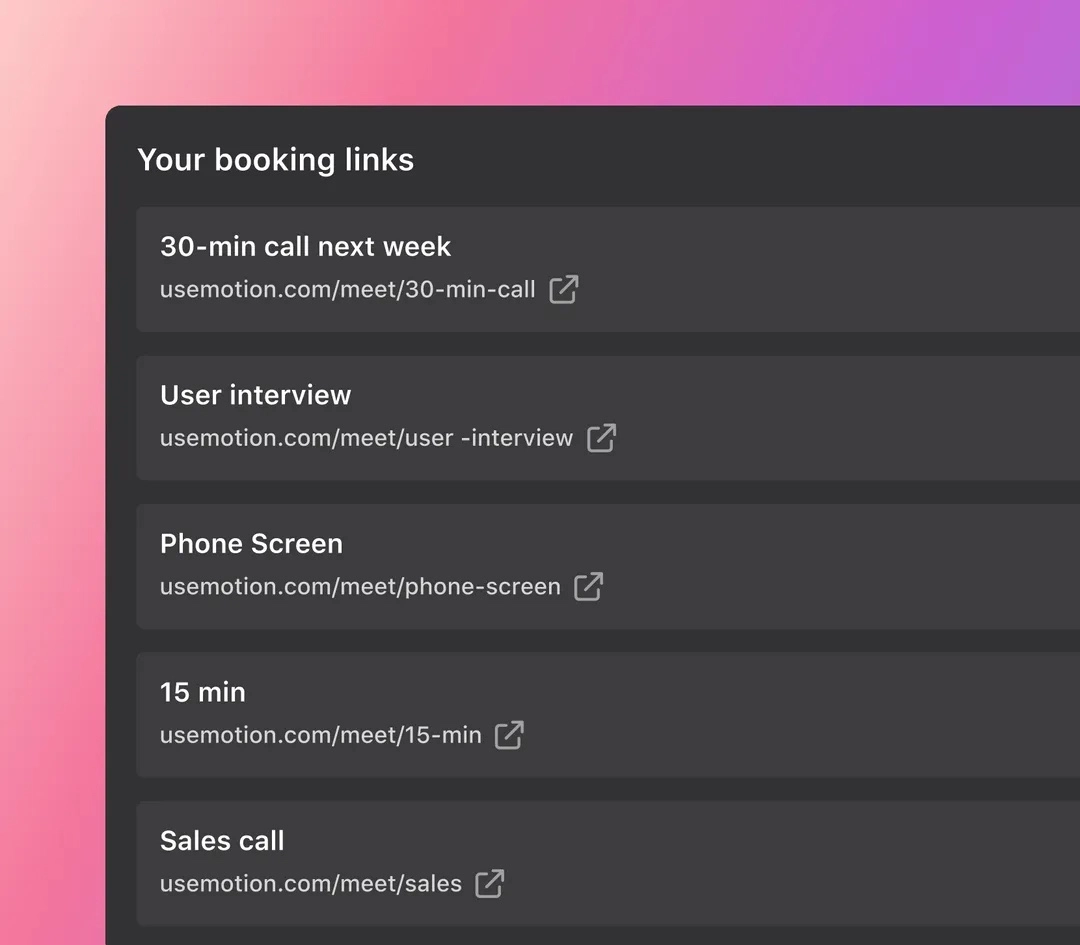 |
Progress tracking
Motion provides a clear view of different agenda items and their priorities. Knowing which high-priority topics need to be addressed first and allocating time for them accordingly helps you create more effective meeting agendas.
Moreover, you can track the progress of tasks assigned during meetings. This makes it easier for team leaders to create follow-up agendas that reflect the team’s actual progress.
Start running more effective meetings with Motion today. Sign up for a 7-day free trial.

Vicki Chen is a content writer and marketer using proven storytelling methods to create high-quality copy and content for SaaS companies. When she's not writing, she's spending time with Taco, her rescue dog.

